Utility and Limits of Dowsing Rods to Chart the Subsurface
Some days ago, I read an interesting article by John Janks on dowsing in Frontier Perspectives, a journal published by the Center for Frontier Sciences. Looking up the term, we find that dowsing is the use of a divining rod or similar instrument that allows you to locate certain energy anomalies that are not normally visible and that not everyone can feel. It is quite commonly used to locate water, especially when people want to dig a well. Oil companies have also employed dowsers to locate oil for drilling - a fact that is less well known.
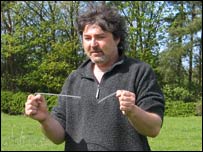
Sean Burkey dowsing - Image source: BBC
What I liked about John Janks' research is its no-nonsense approach and the simple explanation of how, in all likelihood, dowsing works. According to the author, there is no need to have special abilities to use dowsing rods. Practically anyone can go out and try this. If you do, or if you are a dowser and have experience you'd like to share, please don't hesitate to leave a comment at the end of the article.
- - -
Utility and Limits of Dowsing Rods to Chart the Subsurface
ABSTRACT
This paper is an analysis of the phenomenon known as "dowsing" using hand-held wires. "Dowsing rods" move because of large changes in electrical conductivity. Simple tests were performed on buried objects ranging from a few centimeters in diameter to volumes of three liters, and composed of highly conductive metals or highly resistive ceramics and plastics. The distance of first detection was about five meters for metallic pint cans to 20+ meters for three-gallon plastic containers. The wires move in a predictable fashion. Blind tests were performed to rule out subconscious movements by the investigators. The presence or absence of water is incidental. Significant changes in electrical conductivity may also be created in the earth by fractures, weathered horizons, and changes in grain size and composition. Coincidentally, these phenomena create higher porosity and permeability, favorable for water production. The use of wire rods has potential applications to military and civilian landmine and IED detection, engineering and archeology.
INTRODUCTION
Dowsing rods*, two hand-held metal wires, have been the subject of controversy for centuries. Advocates use them in the search for water, but others have claimed success finding metals, minerals, and oil and gas deposits. "Dowsing" is classified as a pseudoscience because the practice has never been verified via experimentation or supported by an adequate scientific hypothesis. Previous evaluations have shown that dowsing for water is little better than random chance1. However, there have been published successes, especially in parts of the world desperately in need of fresh water2.
There are a variety of techniques in use: metal rods, wooden sticks, pendulums, even tracing over maps3. There is no consensus as to why dowsing rods move. Most scientific papers scoff at the method, dismissing that the rods move at all (other than by the human subconscious). This paper proposes that dowsing rods obey the laws of physics and move according to the changes in electrical conductivity.
*Two hand-held metallic wires are almost universally referred to as "dowsing rods" regardless of the application. We will follow that convention.
Methodology
The experiment was designed to investigate how dowsing rods move with changes in electrical conductivity. It required two phases:
(1) measuring dowsing rod movement with objects of known size and composition, and
(2) blind tests that would rule out any effects of the human subconscious.
The native soils in Greater Houston Area consist mostly of soils containing fine sand, silt and clay. The water table is at most a few meters below the surface. We performed the test in two regional soils, the Clodine and Gessner Series4. For the tests, we chose a 50 by 50-meter section where no rod movement was detected when an investigator walked the area at two-meter intervals.
Basic Experiments
Three metallic containers (US pint, quart and gallon cans), a three-gallon plastic container, and a 20 cm ceramic disk (those "Bott Dots" you drive over when straying into another lane) were used as the test objects. Each item was analyzed individually. The investigator walked the area as before, and noted rod movement patterns and distances for each buried object. The information included when the wires first moved, the angle of each, and any information about the shape of the object.
Blind Tests
Blind testing was necessary to rule out subconscious influences on the part of the investigator. Without these tests, any rod movement could be dismissed on this basis alone. We performed tests under three separate circumstances:
(1) 50 by 50-meter section of forested land,One investigator buried the test object on a day when the other was not present. The investigator took great pains to make sure there were no visual clues. After waiting 24 hours (to ensure even soil dryness) the second investigator, alone, examined the study area using the rod positions to locate buried object. This test method is probably a good simulation of the placing and recovery of buried objects like landmines or IED's.
(2) 50 by 50-meter section of scrub and grassland, and
(3) a meandering 70-meter sand trail (about two meters wide) through a forested area.
RESULTS
In the first phase of the investigation we found that dowsing rods moved in a predictable pattern. But, unless the investigator approached the object directly, the dowsing rods did not move equally. In our experiments, the rod in the hand farthest from the buried object moved the most, usually at an angle that pointed in the direction of the object (Figure 1).
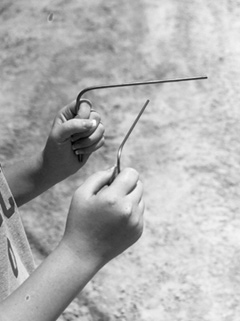
By marking the direction that the wires moved the investigator was able to create a map showing the object's location. One example is shown in Figure 2.
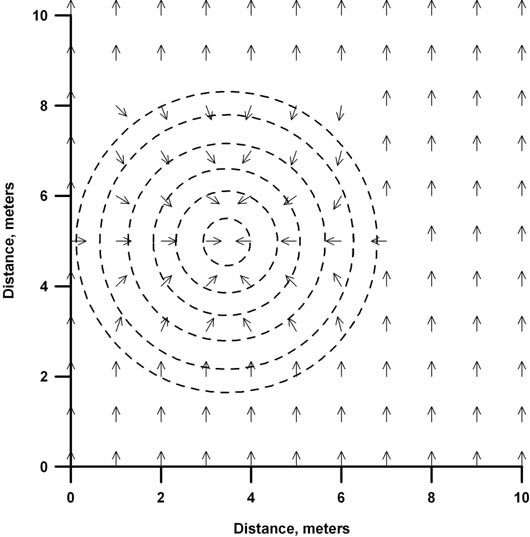
Moving from right-to-left, an investigator would find no rod movement until he reached the traverse at seven meters. Since the investigator did not know where the object was buried he would only see that one rod would move at right angles pointing towards the center of the object. The rod in the other hand would remain straight ahead, creating a "├"-shape. As he continued walking along the lines at 6, 5 and 4 meters, he observed that the area where the rods moved expanded. Once on the left side of the buried object, the investigator would find that the rod movement patterns mirrored those of the right. The area affected depends on the size and geometry of the buried object. The pint-sized can was detected at five meters while a gallon-sized one at 20 or more meters. There is a direct relationship between the size of the object and the distance where the wires first moved:
U.S. Pint (metal) 5 meters Traffic Marker (ceramic) 5 meters U.S. Quart (metal) 10 meters U.S. Gallon (metal) 15 to 20 meters 3-Gallon Container (plastic) 20+ meters
We found that ground cover had little, if any effect on the rod movement. We tested grassy, shrub and tree-covered land, wet and dry soils, and even objects buried beneath used tires and small trash piles. In all cases the size and shape of the area defined by the rods' movements were the same.
DISCUSSION
Why dowsing rods move has been attributed to everything from psychic powers to natural physical forces. Earlier in the 20th Century physical scientists such as Maby and Franklin5 and Tromp6 attempted to explain dowsing rod movement in terms of natural forces, especially electromagnetic fields. Maby and Franklin believed that physical forces acted upon one's forearm muscles to produce a "dowsing reflex" while Tromp considered that multiple environmental factors (sun radiation, ground cover, body movements, etc.) were also able to make the rods move. Our hypothesis is much simpler: hand-held dowsing rods respond to large changes in electrical conductivity, and as such, the electrical properties of the earth are the dominant control.
Complex Electrical Forces
Electricity in the earth is governed by Ohm's Law:
I = E
1. Electrical Conductivity, σ, is a physical property of matter, one of the widest ranges known to science (about 25 orders of magnitude). Natural soil and sediment columns are defined by ranges only since factors such as porosity, water and clay content, layering and composition vary from location to location:
Soils and their electrical conductivity14Sandy dry 10-4
Sandy wet 10-3
Loamy dry 10-4
Loamy wet 10-2
Clayey dry 10-4
Clayey wet 10-2
Materials and their electrical conductivity12Air 0
Pure water 10-4 to 10-2Ground water 10-2 to 101
Dry Sand 10-7 to 10-2
Water-saturated sand 10-4 to 10-2
Clay (saturated) 10-1 to 100
Granite (dry) 10-8 to 10-6
Granite (wet) 10-3
Quartz 10-14
Fused Quartz15 10-20
Limestone 10-9
Iron, coper, aluminium15 107 to 108
Platics and polymers15 10-12 to 10-17
Potting and casting ceramics15 10-9 to 10-11
Rock salt 10-13
Data are from Telford, et al12, unless noted15
2. Electric Field Intensity, E, is complex because the frequencies in a particular section of the earth at any time are a function of the magnetosphere, atmospherics and man-made radio and microwaves. A user standing on the earth's surface encounters frequencies ranging from less than 1 Hz to the GHz portion of the electromagnetic spectrum. For reference, the corresponding wavelengths are 100,000 km (1Hz and lower) to 1 mm (300GHz). A wavelength of 100,000 km is 62,100 miles or about ten times the diameter of the earth.
3. Conducted Current Density, I, is the vector quantity of current passing through a unit area of an equipotential surface; it is the product of the electrical conductivity and the electric field intensity. This density changes markedly as electric currents flow towards highly conductive materials and around highly resistive ones. The rods seek an equilibrium position with I.
Barlow7 first identified natural electric currents. They are now known to cover land and sea and are attributed to changes in the earth's magnetic field8. Global thunderstorm activity creates atmospherics [or "spherics"] ranging from 1Hz to 100 kHz, while man-made frequencies range from 9 kHz to 300 GHz. Changes in space weather phenomena have long been known to create havoc with communications and infrastructure, such as pipelines and railroads9. Telluric current studies are not new, but they are mostly centered on geology, often kilometers deep into the earth. Studies range from shallow subsurface to the mantle-crust boundary and beyond10.
It is difficult to generate serious investigations into why (or if) dowsing rods actually move. Almost universally, the scientific community rejects vague or poorly defined explanations that cannot be tested - and rightly so. Tromp5 was the first to relate dowsing rod movement to changes in electrical conductivity. His exhaustive study concluded that many variables could affect whether or not dowsing rods move: the rod itself, how it is held, nearby vegetation, sun radiation, and body movements among others. This study suggests that rod movement is predominantly controlled by changes in electrical conductivity. Experience has shown that the wire held in the hand farthest from the buried object always moves more than the one held in the hand nearer to the buried object. This phenomenon may in part be explained by some of Tromp's work on dowsing rod movement in human hands.
Gradual changes in conductivity do not generate a conducted current gradient with enough force to make the rods move. Such a distribution of these small changes, no more than a few orders of magnitude are illustrated in Figure 3.
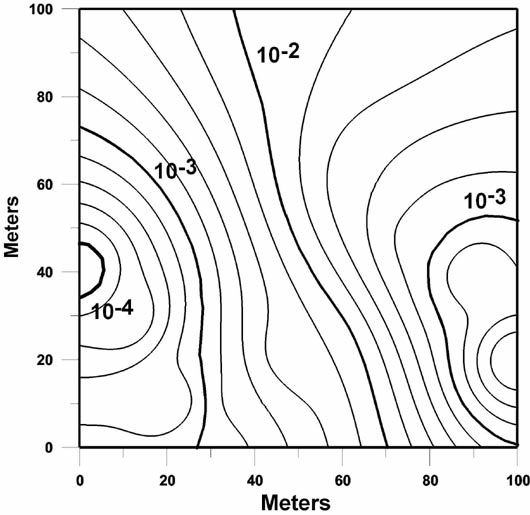
A map the electrical conductivity distribution in the study area. The relatively small changes (two orders of magnitude) over a large area are not sufficient to generate enough force to make dowsing rods move.
Most soils are only intermediate conductors, with conductivities ranging from 10-4 to 10-2 mho-m (Table 2).
However, when a highly conductive metal object is buried in this soil large gradients are established as electric currents preferentially move towards the higher conductivity (Figure 4).
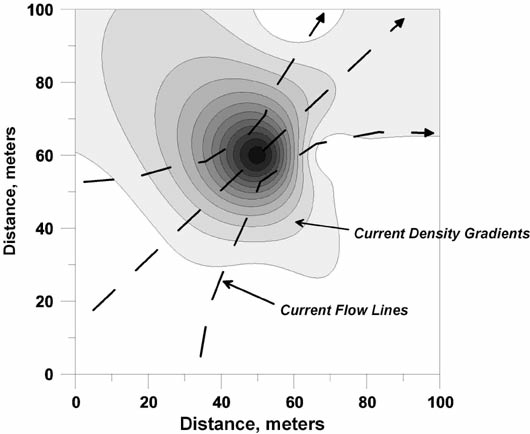
A conceptual model of the area shown in figure 3 after a metallic object with an electrical conductivity of 108 mho-m is buried in the soil. The difference in electrical conductivity between the metallic can and the soil in which it is buried is about twelve orders of magnitude. Three conducted current flow lines are illustrated preferentially moving towards the highly conductive metal.
In this example a metallic can with an electrical conductivity of 108 mho-m is buried in a wet loamy soil of 10-2 mho-m, generating a difference of about 100 billion mho-m. Thus over a small area, the conducted current density rises sharply (Figure 5).
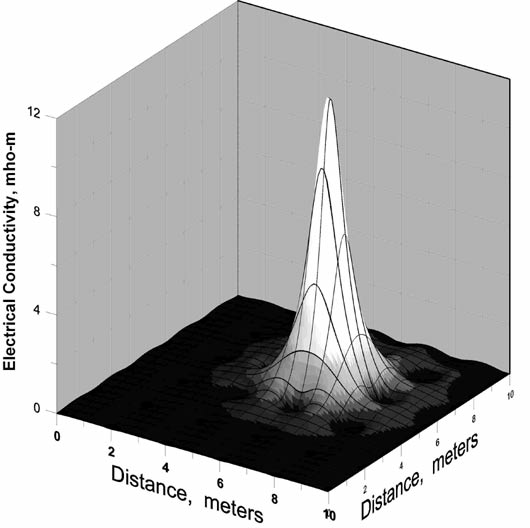
Figure 5. A 3-D model showing how conducted electrical current densities would change in the presence of a highly conductive metallic container. Electric currents would preferentially flow faster through the metal, creating a large gradient in the conducted current. The z-axis is shown in orders of magnitude.
The dowsing rods align themselves perpendicular to the equipotential surface. The distance that the user first detects rod movement is proportional to the size and geometry of the object. The larger the container the more electrical currents will preferentially move to the higher conductivities, essentially acting as a current sink or a "short" in the system. This is precisely the reason geophysical resistivity studies must avoid fences and pipelines. Plastics, ceramics and other highly resistive materials force the currents around the object, concentrating them along the object's margins.
While this test was limited to the materials already described, it is likely that natural features create significant, if smaller, changes in conductivity: weathered horizons, fractures, grain size and composition contrasts. Similarly they may also create enough force to make the wires move. The dowsing rods respond to any large change in conductivity be it buried metallic objects, resistive ceramics and plastics or natural features. And they're not picky.
Parameters that are constantly changing and difficult to measure are time-consuming and require expensive equipment. The instability and variations in telluric currents and magnetotelluric fields is one reason most geophysical methods choose instead to negate them11 or select specific frequencies12. However, expensive methods and equipment are precisely what most of the world's population does not have available in its search for clean water. Hence, the attractiveness of simple dowsing rods.
Electrical Properties and Successful Dowsing
Because movement of dowsing rods is a function of electrical conductivity, they offer hope for finding potable water sources in countries too poor to afford highly expensive geophysical methods. It is not just buried metal or plastic containers that can create these changes in the current density. Faults, fractures, weathered horizons, and abrupt changes in grain size do so as well. Coincidentally, these conditions also generate porosity and permeability - areas that would have a marked increase in water production. Betz2 noted that water flowed only in those areas highly fractured or weathered, and that resistivity measurements changed significantly over the productive well sites.
Thus, for example, a series of fractures in granite bedrock may be sufficient to make the wires move, but whether a well drilled into them is productive or not depends upon something not measured by the dowsing rods - the presence of a water source. When a source of water fills those fractures a dowser will find success. With no source of water, the dowser will fail. Tromp5 recognized this and sought to use his dowsing methods in conjunction with standard geological methods. In other words, the dowsing wires locate potential zones where water could be found, not its presence. This is the exact principle used in oil and gas exploration - a high-technology industry with a success rate of 35% (1973-2003)16.
Additional Applications
Hand-held dowsing rods have applications beyond looking for potable water. The ability of rods to anticipate buried objects may be useful for both military and civilian groups that deal with landmines and Improvised Explosive Devices (IED's). The technique here would be of significant value because (1) IED's and landmines are made of either highly conductive metals or highly resistive plastic and (2) high-tech equipment is not commonly available. Almost any material firm enough to be bent into the "L"-shape of a dowsing rod can be used, thus making them easily available to anyone. In a field situation, they could also be used to locate pipelines, sewers, and other buried structures (engineering). In fields like archeology they could be used to locate artifacts, buried walls and burial sites.
CONCLUSIONS
"Dowsing rods" have been a source of controversy for centuries. Our study suggests that the rods move because of large changes in electrical conductivity not the presence of water. This was tested by burying highly conductive (metal) and highly resistive (plastic and ceramic) in local soils. These objects ranged from one pint to three gallons made of metals, plastic and ceramic. Field tests show that the wires move from five (metallic pint) to 20+ meters (three-gallon plastic) when approaching these buried objects. Certain geologic conditions also create considerable electrical gradients: fractures, weathered zones and changes in grain size. All, coincidentally, are favorable for successful water production. Because they are inexpensive the rods may be useful for a variety of military and civilian applications, such as landmine and IED detection, where high-tech equipment is not available.
REFERENCES
1. Vogt, E. Z. and Hyman, R. (1979). Water Witching U.S.A. University of Chicago Press, Chicago, IL, 260 p.
2. Betz, H. D. (1995). "Unconventional Water Detection: Field Test of the Dowsing Technique in Dry Zones, Parts I & II." Journal of Scientific Exploration, 9(1, 2).
3. Bird, C. (2000). The Divining Hand: The 500-Year Old Mystery of Dowsing. Whitford Press, West Chester, PA (US), 372 p.
4. Soil Survey Staff (2004). Official Soil Series Descriptions. Natural Resources Conservation Service, U.S. Dept. Agriculture [online].
5. Tromp, S. W. (1949). Psychical Physics: A Scientific Analysis of Dowsing. Elsevier, NY, NY.
6. Maby, J.C. and Franklin, T. B. (1939). The Physics of the Divining Rod. G. Bell & Sons. London.
7. Barlow, W. H. (1849). "On the Spontaneous Electrical Currents Observed in the Wire of the Electric Telegraph." Phil. Trans. R. Soc., 61A.
8. Sheriff, R. E. (1989). Geophysical Methods. Prentice-Hall Publishing, Englewood Cliffs, NJ, 605 p.
9. Lanzerotti, L. J. (2001) "Space Weather Effects on Communications," in Daglis, I. A. (ed.), Space Storms and Space Weather Hazards. Kluwer Academic Press, The Netherlands, 313 - 334.
10. Lanzerotti, L. J. and Gregori G. P. (1986). "Telluric Currents: The Natural Environment and Interactions with Man-made Systems." in The Earth's Electrical Environment. National Academy Press, Washington, D.C., 232-257.
11. Morrison, F., Gasperikova, E., and Washbourne, J. (2004). The Berkeley Course in Applied Geophysics.
12. Telford, W. M., Geldart, L. P., Sheriff, R. E. and Keys, D. A. (1976). Applied Geophysics. Cambridge University Press, NY, NY, 859 p.
13. Simmons, M.R. (2003). "Energy Technology Overview." Trends and Strategies for Funding E&P Technologies. Offshore Technology Conference, Houston, TX, May 5, 2003, 27 p.
14. Herz, N. and Garrison, E. G. (1998). Geological Methods for Archeology. Oxford University Press, NY, NY, 343 p.
15. Physical Properties Database (2006). www.Matweb.com
16. Simmons, M.R. (2003). "Energy Technology Overview." Offshore Technology Conference 2003 Technology Commercialization: Trends and Strategies for Funding E&P Technologies. Houston, TX. May 5, 2003. 27 p.
There are now 7 YouTube videos on the Dowsing Rod Empirical Experiments.
(Videos by John Janks)
(Summary and Introduction)
(Field Work)
(Objects Buried Beneath Surface Clutter)
(Multiple Buried Objects)
(Electrical Conductivity)
(How it works - Ohm's Law)
(trip wires, pipelines, bricks)
See also a new (May 2010) article in the Journal of Borderland Research titled
Dowsing Rods: Empirical Evidence and Applications for Charting the Subsurface
"This paper is a summary of the empirical evidence we discovered while working on locating buried objects. Our object was to develop a scientifically based method for individuals to locate buried objects and aboveground tripwires. We used only a brass pair of rods, bent into the familiar "L" shape. The data consistently show repeatable patterns that depend upon the size and shape of the buried object. The objects used in the testing were made of metal, ceramic and plastic. Some objects were detected as far as 20 meters away, and above ground trip wires, some as thin as 1 mm in diameter were also located with relative ease. The patterns created by combinations of buried cord or wire attached to a circular or rectangle object were successfully charted using this method. When two buried were close enough to affect each other, we detected dowsing rod movement along the axis approximately 60+ meters. In an unanticipated discovery, we found a user remaining stationary could track the path of low flying aircraft. In all our experiments, the rod farthest from the source moved the most. We found that the presence or absence of water had no effect on the outcome. We believe that dowsing rods could be applicable to both military and humanitarian demining, and encourage active testing. While we did not have the tools or funding to study it, we believe that earth-born Telluric Currents are the most likely candidate for creating dowsing rod movement. Fourteen videos have been published on YouTube and their URLs are located in the appendix."
Added December 2010:
Video: No Link Between Dowsing Rods and Ideomotor Effect
The video is a demonstration that the ideomotor effect, an "explanation" by various theoreticians that the movement of dowsing rods is caused by involuntary muscle reactions of the operator, is merely a theory. The video shows
"A field experiment demonstrating that the Ideomotor Effect is not related to dowsing rod movement. Simple equipment, cardboard tubes, metal rods, and most importantly a 360 degree swivel. Over a buried pipeline the lower tube with dowsing rod moved freely while the upper remained unmoved. Attempts to turn the lower rod by turning the upper one were equally foiled by the swivel. Hand-held dowsing rods passed over the area, moved in the same manner and location."




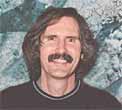
I use dowsing rods to locate graves. Our town cemetery is dated from 1795 and I have located a number of graves outside the walls. A friend and I also found another cemetery (a potter's field) at the other end of town. My friend has found fossils by dowsing and also located a mass grave from the Civil War. He once found the unmarked grave of a murderer who was buried outside a cemetery. He can walk across an umarked grave without rods and tell me where it is. I have verified his findings with rods. I contend that there is some psychic connection with dowsing and a person can find whatever he is looking for.
GOOD MORNING SEPP--- GLAD TO SEE AN ARTICLE ON DOWSING HERE. IN THE MID 1970'S I TAUGHT A YOUNG PETROLEUM GEOLOGIST, NORMAN POCOCK,THE ART OF DOWSING WHILE HE WAS ATTENDING MY SCHOOL OF BLACKSMITHING.. AFTER HE RETURNED TO HIS HOME IN CALGARY, ALBERTA, CANADA, HE USED THE ART TO MAP OUT AND LAY CLAIM TO THE RED RIVER FIELD WHICH WAS AT THE TIME THE LARGEST AND RICHEST OIL FIELD IN CANADA. SUBSEQUENTLY HE BECAME VERY WEALTHY, BUILDING THE TALLEST BUILDING IN CALGARY TO HOUSE HIS OFFICES.
SINCE THE MID 1980'S I HAVE MADE MY LIVING AT DOWSING AND HAVE BECOME INTERNATIONALLY RECOGNIZED FOR MY WORK IN DOWSING FOR GEOPATHIC STRESS IN RELATION TO HEALTH.
MARIE DIAMOND, IS A FENG SHUI EXPERT KNOWN THROUGHOUT THE WORLD WHO IS ALSO ONE OF MY STUDENTS.
REGARDS.....SLIM....
Hello Sepp,
I appreciate the article about dowsing, because many people think about dowsing as nonsense or hokuspokus. I won't claim that I am a professional dowser, but I dowse on all my architectural projects. From the location, orientation of the building, quality of energy, stress-lines, Dr. Hartmann Grid, and of course water lines. Believe it or not, you can even find water on a site-plan, even if the property is hundred of kilometers away.
I saw the note from Slim Spurling, and I know Slim and his wife Katherina in person. I am not a student of Slim, but I saw several presentations he made, and you would find them very interesting. Slim is a very smart, unique and talented person, and anybody interested in dowsing or quantum physics, should attend his seminars.
All the best,
Wolf
Michael comments (by email):
I spent some time dowsing 30 years ago and found repeated results at specific points in the areas I was dowsing for, even with my eyes closed, so the rods were definitely responding to something in the vicinity each time. I never went any further than that, and I was using bent steel coat hangers. I would compare it to using a pendulum for yes or no answers, etc.
As I described earlier, I feel that the field of consciousness needs to become an integral aspect of scientific study, much as was conducted at Princeton Univ. (PEAR) in their engineering department over the past 29 years, only much more extensive.
Electrical conductivity as the cause of the movement of the divining rods can be ignored, as the movement is the result of attraction and all attraction (from the microscale to the macroscale) is the result of the absorption of emission.
See the materialist paradigm of physics at
members.westnet.com.au/paradigm/forever.pdf (link no longer active - Sepp)
Stephen Mooney
David Yurth comments (by email):
Thanks for sending this along. I,too, appreciate the no-nonsense approach he has taken. The problem with this approach, however, is that it ignores or significantly discounts some important facts. The ability to dowse is not dependent on some mysterious special talent. The fact of the matter, notwithstanding his blanket statement that everyone can do it, is that not everyone can do it. In fact, as with all other human potentials and latent abilities, there are some who can do it much better than others and some who cannot do it at all. It's just like musice or math or poetry or painting - the latent ability is present in the species, but individuals express differing levels of capacity and skill.
Skill is not a good word to use in this context because dowsing is not something that a minimal practitioner can get better at with practice. In the sense that skill suggests the exercise of a trained discipline, then the word is not appropriate. But if we use skill in the sense that it connotes the ability to perform an act with greater or lesser adroitness, than I believe we can stretch the use of it to match our needs.
Dowsing falls into precisely the same category as remote viewing. While the research has shown that everyone has the latent talent, very few can do it really well. Most can do it occasionally with hit or miss results, but there are some like Ingo Swann and Joe McMoneagle who are truly superior at it. And as with all such things, there are pretenders and charlatans like David Moore, who can talk the talk but lie about their ability to walk the walk.
So this subject is far from being satisfactorily disposed of, as this author would have us believe. There is much more to dowsing than is dreamt of in your world, Horatio.
D. Yurth
This is an article from Miroslav Provod, the author of "Of Auras and Cosmic Energy". (For a good understanding of this article, linked one should be read first.)
Dowsing versus aura
Miroslav Provod
What is the natural force that causes the dowsing rod to move is only one question of many for which we are still trying to find the answer. However, we are not the only one trying to answer this; the same case could be found in Physics. Cited from specialists’ literature – “We do not know why this happens; we just know the experimental fact that two positively charged bodies repel each other”. It’s therefore not logical to doubt the movement of a dowsing rod in connection with this information, because a similar mystery is also in Physics. It can’t be excluded that an identical natural force moves the dowsing rod. Other than that, it was found by doing an empirical research that the known physical phenomenon of “charge flux” doesn’t work only in a laboratory, but everywhere in nature. It’s not easy to believe that the phenomenon of charge flux was already known and used by our ancestors when menhirs, Babylonian towers, pyramids, obelisks and all types of holy structures were built.
I have been using a kind of dowsing rod for many years, which is also known as “little butterfly (motýlek)” in the Czech Republic.
At the beginning I wasn’t able to orientate in the reactions of the dowsing rod, but everything changed when I found by chance an example replacing unit, something like etalon (from French, meaning 'measuring gauge' or 'standard') . It was the high voltage power lines, whose energetic components (aura, zones, inter zones) don’t move and could always be found in the same place. I did the first series of experiments in an environment, where I got experience that I then rechecked with other sources. I can recommend everyone who is interested in the research of dowsing to do the same. It is easy and very educational.
How to identify energetic components of high voltage power lines
Firstly, we have to make a dowsing rod from a wire of 3 mm diameter in a way that we take a 24 cm long wire, which we bend in the middle so it becomes U shaped. Then we stretch both its parts to have it like in the picture (above) in a way that the front side of the dowsing rod is 5 cm long. Then we have to find a high voltage power line (between 22 kV and 400 kV) in the vicinity, which is perpendicularly intersected by a not very busy road with a hard surface, and we can begin to build the “etalon” measuring units. We take the dowsing rod loosely between our thumb and middle finger. It is necessary that it sticks out of our aura so we need to hold it approximately 50 cm from our body. We can’t try this after alcohol consumption. In this case even a long hand is short (the dowsing rod doesn’t stick out from the aura of our body).
The aura is identified in a way that we go on the road from the middle of the high voltage power lines in one way until the dowsing rod reacts by bending either left or right. We mark the position of this dowsing rod reaction and in the same way we find the location of the dowsing rod reaction on the road in the other direction. If both these distances in the opposite directions are the same, we have worked precisely and the distance between opposite locations is approximately the diameter of aura of the high voltage power lines. The aura of high voltage power lines copies the shape of the source and has the shape of a cylinder and its diameter is in the range of tens of meters (depending on the voltage).
Next we have to find out about the properties of aura, which give us a hint about much information needed for further identification. At first, we check that it doesn’t matter whether we go forwards or backwards with the dowsing rod in a way that we repeatedly walk backwards both directions – the dowsing rod will react in the same places. This fact comes well into use when we identify objects with small dimensions of aura, for example in the case of a human body, where it is not easy to distinguish between the border of aura from the reaction of a zone, etc. The dowsing rod has an answer for the question, whether we are located in the area of aura or not. We go with the dowsing rod in any direction in a way that the dowsing rod reacts in the rhythm of our steps by short movements to the left and right, but not in all cases, only when we walk at a certain speed. Everybody can find the right pace of walking in a few minutes. All the identifications need to be preceded by trying whether we are or are not in the space of aura. The common aura of a dense urban area could occupy large areas in the same way as a stadium that is full of people or an unmoved grassland, etc. The dowsing rod “motýlek” doesn’t react in the space of the aura. – the aura of our body gained a common aura with the one where we are located and so it doesn’t have an object with which it could react.
The dowsing rod reacts with energetic components in the perpendicular direction or in the direction that is not much deviated from the perpendicular direction. The greatness of deviation from the perpendicular direction could be found just with a little information, while we increase the deviation with each trial. We use this fact while looking for an energetically clear place, we realise that such a place needs to be crossed with the dowsing rod in more than one direction.
The same procedure would be used when looking for energetic zones. We go from the edge of the aura in one direction until the dowsing rod reacts, which we then mark again. Then we do identification in the opposite direction just to check. If we worked precisely, both distances between the aura and the zones are the same. In this way we mark other zones. It’s not possible to find out the number of the zones. We will verify a rule, which works not only for the zones of high voltage wires, but also for zones of all other sources. Every first and second zone has the same width, but every third zone is about ten times wider. In the case of the zones of high voltage power lines, the first and the second is about 10 cm wide, the third about 100 cm. I have no clue why this is. Hopefully, someone of you will find the reason. We remember that the gaps between zones of high voltage power lines are about 10 meters wide. The zones, in the same way like aura, copy the shape of the source like skins. At greater distances from the source they gain large volumes.
Between the zones there are four inter zones, in some cases there are more. They are located closer to the zone in the direction towards the source (in our case towards the high voltage power lines). They could be identified with a dowsing rod if we make its front part longer by one centimeter. However, such a modified dowsing rod also reacts with the zones so we can use it only if we have done marking the zones. Now we have marked all three high voltage energetic components, which don’t move – it is an optimal etalon for further research. Next we could compare the reaction of “motýlek“ with the reactions of other types of dowsing rods and make first statistical data. Other data could be obtained by changing the sizes of dowsing rods.
The energetic components of any other sources could be obtained in the same way – a source is any lump of matter and we mustn’t forget that by the inter contact of auras the sources gain one common aura. I could recommend getting further energetic experience with a small stream by a similar technique as with the high voltage power lines. By this, we remove the doubt that in the case of high voltage power lines the aura has something to do with the electromagnetic field. I recommend finding a similar place, like a bridge where a stream flows under a road. When identifying all three energetic components of the stream, we use the same technique as with the high voltage power lines. The result will be the same, except that we find that when the rate of flow of water changes, its energetic components will move. I shall recommend making a graph of an inner and outer bend of a stream – there will be a greater density of zones and inter zones on the inner bend. We will understand then why people used the inner bends to build certain structures. Such a place has more energy, which then accumulates in the mater of the structure. The moving zones of a stream give energy to the surrounding vegetation. In the same way, any other matter, including humans, could gain this energy. It’s a new knowledge to us, but people already used it in the ancient times.
By monitoring the energy of a stream we learn to look for water springs. The zones of springs are easily distinguished from high voltage power lines zones by the fact that they change their direction and mainly because of different separation of the zones. When trying to identify a spring we find and mark at least three zones and the inter zones between them. By using the rule that the inter zones are located closer to the zone that is located in the direction of the source (the water spring) with respect to them, we easily get the direction in which to go. By finding and marking further zones in that direction we find, by looking for greater separation, the aura. In the middle of the aura, the place where the dowsing rod doesn’t react is the spring. In another case if the spring is located deeper, the cylindrical aura is also located under the surface. In such a case the clue is given by the inter zones that are always located closer to the zone that is situated towards the source with respect to them. In the middle of the location where the inter zones between two zones point towards each other is the water stream. However, we have to realize that there are many energetic components everywhere and in urban areas it’s almost impossible to orientate between them.
In a habitable house the sources are the matter of the house, electric cables, all kinds of electric components, water and heating pipes, all metal, zones that intersect the building (water springs, streams and rivers located far away, energetic wires, cumulus (thunderstorm) clouds, etc. If the auras of these sources are in contact, they join into one common source with a common aura. A large group of zones that are conductive for the cosmic energy doesn’t create its common aura, but can manipulate the energy of the building in both directions.
Other useful knowledge could be gained when drawing the energetic graph of an automobile, which consists of these sources – all the metal, the air pressure in the tires (this could be easily verified with one tire by increasing its pressure), all kinds of electrical components, the chemical reactions occurring when the engine is running, the energy of the fuel in the tank and the matter of people in the car. In this case the auras of all the sources overlap each other so the car becomes one source with a common aura. The graph could be constructed in a way that we place the car in an energetically clear space and draw its position. By the known procedure we find its aura with the use of a dowsing rod and then add it to the graph. We do the same when the lights and other electrical components are on, with the engine started, when a driver sits in it, with greater revolutions per minute of the engine and with more passengers. In this way we could observe the increase in size of the common aura.
You will be surprised by the difference in size of drivers’ aura before a journey and after it. Also, you will likely think about a situation when there is traffic jam on a road. All the vehicles gain one common aura in this way, which is intersected by an uncountable number of zones and its energy is increased in this way. The greater aura of organisms shows greater charge on the membranes of our cells. We could do an easy experiment with capacitors to confirm that great aura creates health problems including thinking mistakes.
After a short break from our trial etalon we return to it with more experience. You can do experiments with anything that comes to your mind. I recommend starting working with an assistant whose differences in the size of aura after an hour in an aura or a zone of high voltage lines could be monitored. It won’t be less interesting to monitor how long it takes for the aura of your assistant to get into its original size in a clear location. You will be surprised what happens with his or her aura if you put a small bottle of alcohol into his or her pocket. You won’t miss the fact that dowsing rod can reliably indicate the presence of alcohol in a human body to an extent, when common detectors don’t anymore.
When the assistant is on a metal bed he or she has a common aura with it. I could recommend placing this bed out of all zones. You can go back to the ancient times and create menhirs from rocks near water streams. You easily get to know by experience that a menhir has more energy in vertical position then in horizontal position. If you think about the actions of people in history, you have to consider the fact that in those times there were only natural sources present on the Earth. I can’t judge by how much these natural energetic sources were increased by the sources of our civilisation. In the air there are thousands of aircrafts that interact with all cumulus and cumulonimbus (thunderstorm) clouds. On the ground these are the great cities, power stations, power lines, millions of vehicles, hundreds of thousands of ships on the sea, electromagnetic waves that are present everywhere, etc. The attempt of medics to manipulate the energy of a human body in this way could cause negative reactions as we don’t know the optimal value of the capacitance of the membranes of our cells as measured by the size of the aura and also we don’t know the properties of aura. We have to wait for the view of specialists or for the construction of measuring devices that could be built into mobile phones in the future.
We still don’t know what natural force moves the dowsing rod but we could definitely mark the places where it reacts. These could be the starting point for further research. It’s hasn’t been explained yet why the dowsing rod doesn’t work for some people. However, there is information in history that could have something in common with this problematic.
March 2007
Miroslav Provod
http://www.miroslavprovod.com
John Janks sent the following links by email:
Here are the first 6 YouTube links on the Dowsing Rod Empirical Experiments. I'm not the best videographer nor do I have great taste in music, but nonetheless, they're here. I tried to make it understandable to everyone, but have found the physicists trying to pick things apart.
Look them over if you're interested.
1. http://www.youtube.com/watch?v=0Zs_UvYb8Pg (Summary and Introduction)
2. http://www.youtube.com/watch?v=46OOC5H3kO8 (Field Work)
3. http://www.youtube.com/watch?v=SMU9OWaxnSI (Objects Buried Beneath Surface Clutter)
4. http://www.youtube.com/watch?v=N34hf7Ox5QA (Multiple Buried Objects)
5. http://www.youtube.com/watch?v=hEarOzooDcA (Electtrical Conductivity)
6. http://www.youtube.com/watch?v=6jKeNTmK1ps (How it works - Ohm's Law)
John Janks
Interesting posts, a pleasure to find believers. We dowse many things too. I believe we expand our right brain to access the universal knowledge. I'm sure "Black Trackers" in Australia find their target by dowsing with out rods. I need rods but my wife can feel graves just by walking near them. The witch hunt goes on to stop us in the form of fluoride and conola oil